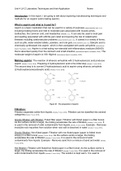Other
Distinction - BTEC Applied Science Unit 4 LA C: Learning aim C: Explore manufacturing techniques and testing methods for an organic solid.
- Course
- Institution
Learning aim C: Explore manufacturing techniques and testing methods for an organic solid.
[Show more]



